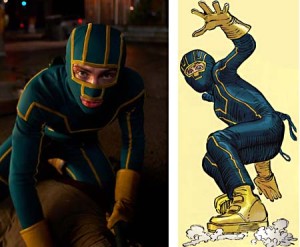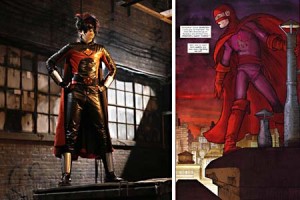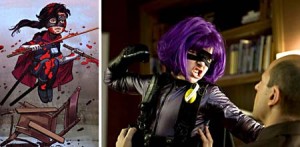
Every boy dreams of becoming a superhero and fighting crime. Then he wakes up, realizes that’s a dumb idea, and gets on with his life before he gets his dreams and skull crushed. Same thing tends to apply when a comic writer dreams that there will be a faithful movie adaptation of his creation: When it gets to the big screen, he just cringes through the premiere, takes the paycheck, and retreats to his fortress of solitude.
So nobody would have expected a comic like Kick-Ass, in which a nerdy teen decides to become a costumed vigilante, could make it to the screen intact. Yet somehow the tale of powerless and clueless less-than-super heroes has become one of the crudest, lewdest, and wildly entertaining big-budget indie films ever.
While Kick-Ass the comic seems like a poke at mainstream superheroes, it’s actually published by Marvel Comics where …. Hold up; we need a secret origin flashback: In 1993 a young Scottish writer named Mark Millar started working for the British anthology comic 2000 AD. America beckoned, and the Scot crossed the Atlantic to work for DC Comics and then Marvel. There he met artist John Romita Jr., son of industry legend John Romita Sr. and a superstar sketcher with a reputation for down-and-dirty, action-packed panels. The pair collaborated on the superbloody “Enemy of the State” storyline for the firm’s top-selling Wolverine title. Millar said, “After it was finished, we said, ‘Let’s do it again,'”
Marvel, eager to keep Millar writing its big-gun titles, allowed him to self-publish his less mainstream, creator-owned work through its Icon imprint – the perfect home for Kick-Ass. When it came to the gritty, crude, and bloodily realistic tale of a dumb kid in a mask, Millar knew it was time for a team-up. “The honest truth is, I only ever had Johnny in my head doing this, and I told him I would wait a year for him. It’s kind of like when a director has an actor in mind. Anyone with too clean a style, it just wouldn’t have worked. I can’t visualize these characters being drawn by anyone except him.”

At this point, enter evil genius and Layer Cake director Matthew Vaughn. Introduced to the comic creators through mutual friends and eager to do a superhero movie his way, the director proposed expanding the team. Millar recounted: “He asked, ‘Do you have any creator-owned stuff?’ So I showed him some things, and Kick-Ass was what he liked best.” When it became clear that no studio would touch the project without cutting the four-lettered language, the violence, and basically everything else that makes the project fun, they decided to pay for the movie themselves (not too hard when you can count Brad Pitt among your producers). With the first issues of the comic getting rave reviews and the total creative freedom that comes from being self-financed, the film green-lit itself. Millar said, “No agents were involved, much to their horror, and Matthew just started writing the screenplay.”
The next step was casting the not-so-dynamic duo of Kick-Ass and Red Mist. Those are the onscreen costumed alter egos of Aaron Johnson (fresh off a critically acclaimed turn as the young John Lennon inNowhere Boy) and Christopher Mintz-Plasse (known to a generation of high school kids as McLovin fromSuperbad). Seated poolside at the Four Seasons the day before the film’s SXSW premiere, Johnson explained that the script was exactly what he was looking for. “It was great to dive in and experiment with being the nobody kid who dresses up as a superhero and gets the shit beaten out of him,” he said. “For me, I was just at that time where I said, ‘It would be great to do a movie where you’re not playing the heartthrob or a leading good-looking role.'”
“Yeah,” added Mintz-Plasse, drily. “You get so sick of being the heartthrob.”
At least all the stunt work must have turned them into chiseled fighting machines then? Eh, not so much. According to Johnson: “I remember Matthew going, ‘Whatever you’re doing, yoga or going to the gym, you have to stop.’ Not that I was going a lot beforehand, but he just wanted us to be useless and pathetic.” It was a tactic that worked. For the action-packed finale to the film, said Mintz-Plasse: “We had two weeks of training, and that’s all we did for the entire film. And I’m sweating my balls off, thinking: ‘Don’t complain, don’t complain. Chloe’s in the next room doing these crazy stunts.'”

That would be Chloe Grace Moretz, aka Hit-Girl, the 11-year-old blade-swinging and foul-mouthed sidekick to Nicolas Cage’s Batman-homaging Big Daddy. It’s Hit-Girl that gets all the best lines and does the most bad-guy dispatching. Johnson said: “Chloe trained for three months with the guy that trained the cast of 300. She had Jackie Chan’s stunt crew and Jet Li’s stunt double and a whole national gymnastics and parkour team, just for her.”
Meanwhile, back at their secret lair (well, costume fitting), her co-stars continued their quests to be the least imposing heroes ever. “We had these really baggy costumes on,” said Johnson. “Mine was a real wet suit.” At least as Red Mist Mintz-Plasse initially got some fake padded muscles – although, as Johnson grinned at his co-star, “You looked like the Michelin Man.” Mintz-Plasse (a self-confessed son of a major comics fan) agreed. “Yeah, I had shoulders up to here and my arms are out there, and the collar was tight so I had neck fat coming out. So we said, ‘This is just not happening.'” Vaughn was even less impressed with the original version, which was less Red Mist and more red-leather “Thriller.” Mintz-Plasse said: “He walks in and said: ‘It looks like shit. You look like you’ve thrown up Michael Jackson,’ and walks out.”
Costumes fixed, now the film faced its toughest critics: Comics fans who have been burned by movie adaptations before. Millar has been kinder than the fans about what Hollywood did to his comic Wantedwhen they replaced supervillains with assassins (as he puts it, at least it has Angelina Jolie in it), but Mintz-Plasse understood readers’ fury. “The movie was fun,” he said, “but then I read the comic, and I completely understand why comic book fans were angry. It was nothing like the same.”
What surprised Romita and Millar most was how true to the page Vaughn kept Kick-Ass. When they finally saw the finished product, Millar said: “It was like the comic coming alive. Even Johnny’s shots. … I mean, I’m quite ADD about this stuff. I remember how Johnny drew it, and I looked at the pages so much that I recognized that [Vaughn] had the camera exactly where Johnny had the camera.”
Romita said, “There was something Matthew said, that I picked a distance back in the camera angles that was more like a true director than an artist.” Growing up around seasoned comics veterans, Romita had always been taught to shift from close-ups to epic full-page splash panels, just so the reader doesn’t get bored. “But I like to be explanatory, so I leave it in midrange, which Matthew told me that he likes. You can see everything, then you can pull in and out and play with distances. And I said, ‘Shit, that’s exactly what I had in mind.'”
So with readers’ fears allayed, that left only one question: Who would win in a fight – Marvel’s sai-swinging ninja assassin Elektra or Hit-Girl? Without pause, Millar had his answer: “Hit-Girl. Young Elektra didn’t start training until she was about 13, so Hit-Girl would just get in there before then. Head off.”